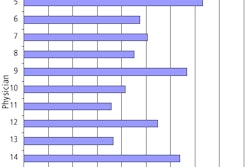CHICAGO - The past few years have seen an explosion of independent freestanding diagnostic imaging centers in the U.S. For academic-based radiology groups, this has meant a steady encroachment on patient volume with a resulting decrease in outpatient revenue. An academic practice from Brown University in Providence, RI, met this challenge head-on by creating and implementing a successful marketing campaign.
"Fourteen years ago, in the state of Rhode Island, there were 12 MRIs serving a population of 1 million people," said Dr. John Pezzullo, who presented results from his group's marketing campaign at the RSNA on Wednesday. "Currently, there are 49 magnets in our state with the same population, and most of those are divided among for-profit imaging centers and nonradiologists."
The impact of this quadrupling of MRI availability in the area has been twofold: the potential for large losses in outpatient revenue and increased marketplace competition, he said. Pezzullo traced the growth of high-end imaging to a confluence of factors.
The technical reimbursement for CT and MR has increased, leading to the addition of the modalities at more independent diagnostic imaging centers. "No one in Rhode Island is rushing to put a mammography unit in their office," Pezzullo noted.
Direct marketing by equipment vendors to physicians and the influx of for-profit imaging companies into the state are factors that have also played a role in the explosion of high-end imaging availability. This has led to an increase in self-referrals as nonradiologists have purchased imaging equipment and to a successful lobbying for the lightening of Certificate of Need requirements by these practices.
The group's 50-radiologist academic practice covers four hospitals and serves the academic department for radiology at Brown University Medical Center. In addition, as a professional corporation, the group has four imaging centers with six MRIs and four CTs.
Prior to implementing a marketing effort, the MR and CT volume was 774 and 1,099 exams per month, respectively, at the four imaging centers. In 2002, the group hired an external marketing consultant, and created an in-house marketing department and strategies for direct-to-patient marketing as well as direct-to-physician marketing.
The external consultant performed an initial marketing overview of the catchment area, including a market analysis of patient and physician demographics, physician referral patterns, and competing entities, Pezzullo said.
"We also had focus groups with referrers and nonreferrers to establish why our referrers were referring to us and why our nonreferrers were referring to the competition," he added.
According to Pezzullo, the four full-time employees of the in-house marketing department were instrumental in creating and executing a comprehensive marketing campaign, employing both direct and indirect techniques, to achieve four goals:
- Increase the number and loyalty of referring physicians.
- Increase the number and types of CT and MR exams performed.
- Distinguish the practice from the competition.
- Educate consumers.
The group's direct-to-patient marketing efforts have included a new graphic identity and branding for the group, print and radio advertisements, press releases, office brochures, billboards, and Web site development.
The marketing initiative for direct-to-physician efforts has focused primarily on education and service, Pezzullo said. This has included radiology case breakfasts, physician luncheons, continuing medical education (CME) lectures, and a promotion package for front-office staff. In addition, the practice added Web-based distribution capabilities so its referring physicians would have the ability to view patient exam images and reports online.
The physician luncheons occur approximately three or four times per week, and are conducted by a radiologist at a referring practice office, Pezzullo said.
"This is basically where a radiologist from our practice goes into the referring clinician's office, sits down, and discusses concerns they may have about our services, any questions they may have about imaging protocols, even case reviews if necessary," he said. "These luncheons are really key because they allow us to develop relationships and loyalty."
After implementing its marketing strategy, MR volume increased to 1,158 and CT volume to 1,409 exams per month.
"This represented a 54% gain in MR studies over premarketing levels, despite the fact that 16 magnets were added during the time frame we didn't own," Pezzullo noted. "We also saw a 33% increase in CT volume despite the fact that two CTs were closed."
In addition, the number of first-time referrers rose 20% in the same time period, he said.
"By putting a face with the name that appears on the report, we've been able to develop referring physician loyalty," Pezzullo said. "The thing that really proved to have a positive impact on our practice was providing the personalized touches to our referral base."
By Jonathan S.
Batchelor
AuntMinnie.com staff writer
December 2, 2004
Related Reading
Staged marketing helps imaging center achieve a grand opening, September 8, 2004
Imaging business plans are all about the money, August 3, 2004
Impactful marketing in healthcare, May 14, 2004
Six Sigma tools improve patient throughput, January 2, 2004
Medical conferences bring market muscle to imaging center technology, November 5, 2002
Copyright © 2004 AuntMinnie.com



















